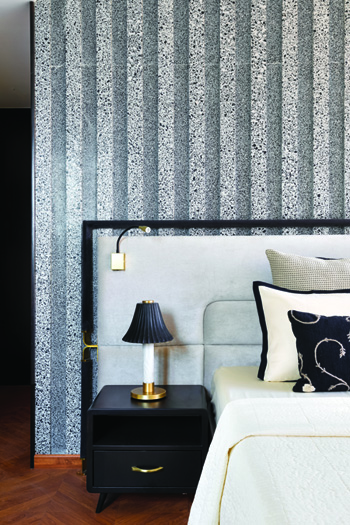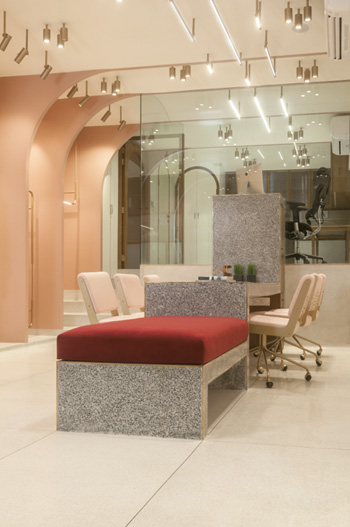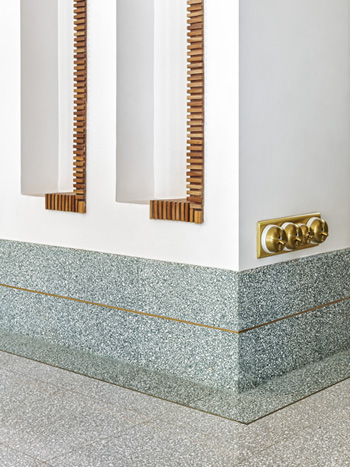100 Years
100 Stories

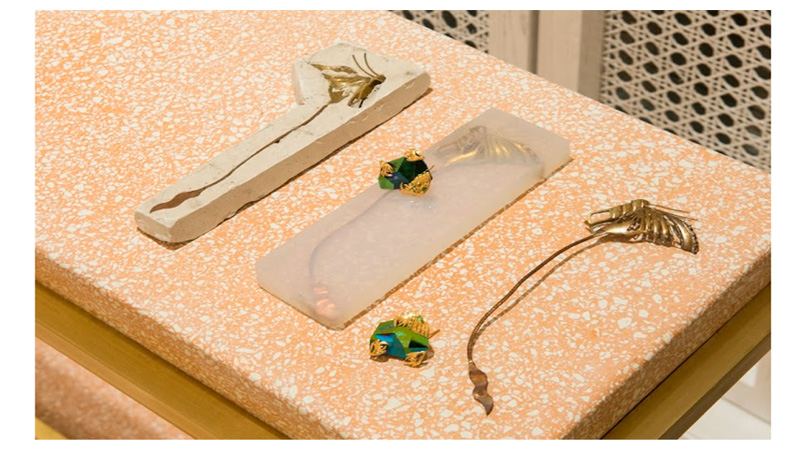
A cast-in situ Peach terrazzo Tabletop at Outhouse Jewellery, Mumbai
Terrazzo? On a wall, you say ? Are you sure?
When Sara Sham of Essajee’s Atelier was designing Bharat Vice Chairperson Firdaus Variava’s new home, the idea was to do something daring. Terrazzo had always been used on floors and as dado. But an entire terrazzo wall? Would that work? Sara Sham says, “The one thing that was really fun in Firdaus' house was that they had never used a cast terrazzo fluted slab on a wall. It took us many many months to put the whole thing together.” The colours decided were grey and white with alternating strips. It wasn't easy though. A mould had to be made for the fluting and the terrazzo was then carved out of it. Four different slabs were made and then assembled on the site. The experience for all those involved was one of experimentation and adaptive thinking. And the result was fantastic. The experiment had resulted in a modern, unprecedented design accent.
This was only one of Bharat's experiments with the centuries-old terrazzo material. Terrazzo was resurrected from obscurity when Pinterest listed the material as an on-trend product in its 2018 trends report and it quickly became the darling of interior designers for the distinct personality it adds to each project. A composite material featuring a medley of marble chips, its strength and durability made this speckled surface a fashionable decor trend. Not only limited to decor, but the traditional terrazzo material has also now been given a re-engineering in line with the times. It can now be found everywhere on floors, walls, tabletops, benches and on other decorative accents!
The origin of terrazzo can be traced far back to fifteenth-century Venice when marble workers combined leftover pebbles with clay to create a new, less expensive material. They honed their technique and eventually replaced clay with cement. As a result, the first terrazzo floor, as we know it today, was created. The original terrazzo-patterned flooring can still be found in old Italian palaces and became the standard in stately homes of the time.
Bharat Flooring and Tiles, with versatile terrazzo tiling options, completely reimagined the traditional aesthetic and gave it a head-to-toe makeover with stunning splashes of colour. Aman Amin, CoFounder of Compartment S4 points out, “Terrazzo as a process has been around us since almost, I would say at least since more than 100 years.. I think Bharat Floorings has been one of the first companies to formalise that process and also make it much more accessible for people to use it now. These skill sets are very specialised and they were almost dying. In that sense, we were quite happy to encounter some organisation like Bharat Floorings that's retaining these skill sets within India.”
Designers who dared to experiment with trends have used BFT's terrazzo tiles in a variety of interesting projects. Outlining why terrazzo is increasingly favoured by designers and clients alike, Tania Khosla, Founder and Director, TSK Design says, “There's something about terrazzo and its uniqueness. No two tiles are the same. The unevenness of it, and the feeling of a hand in it. It appeals to a segment of people who want human connection.” A few notable projects would include the terrazzo wall in a private residence in Mumbai designed by Essajee’s Atelier, the cast in-situ terrazzo tiles used on the floors and walls in a bar, designed by Studio Osmosis; the peach terrazzo tabletop for Outhouse by PROJECT 810 which reflects the brand’s signature colours - salmon pink and grey with brass accents, the terrazzo table in a private home in Mumbai designed by Nishita Kamdar lending the space a modern, high-end decor look, Bharat’s cast in- situ terrazzo cascading table which serves as a monolith terrazzo furniture at the Sarah Design Studio in Mumbai designed by Muselab Design Engine, creating an impeccable aesthetic for the retail space, lending character and personality. Studio Flamingo used green terrazzo as skirting in a holiday home in Goa, showing the sheer variety in applications of terrazzo
If it wasn't already gorgeous, Terrazzo enjoys the distinction of being an eco-friendly building material, as environmentally-friendly architecture becomes increasingly important. It is made from the waste materials of other projects by combining marble scraps, recycled glass chips, and cement. These small particles are combined to create the distinctive terrazzo designs we see, leaving virtually nothing to waste. It is bacteria resistant as it is made from stone and does not contain any VOC or volatile organic compounds due to its natural composition. Highly stain-resistant and easy to clean, it provides a great way to keep the air quality clean with eco-friendly and low-maintenance flooring.
Charita Kishore, principal architect of Studio Skapa Architects and one of the designers who used BFT’S terrazzo, quite aptly mentioned that - “ One thing is that products like terrazzo bring in a sense of nostalgia. There is a certain emotion that we get when we visit, suppose our grandparents’ house, with the flooring and its polishing and quality. Now that terrazzo is coming back in fashion again, people are noticing it more and more. Going forward, it is also a futuristic material. It is very clean and very smart. It goes with many kinds of architecture and interior design. It has a versatility to it. You can get variations by mixing the colours, the chips, and you can experiment with it to a very minute extent-that is also very exciting about terrazzo.”
Bharat’s reinventing of terrazzo in a contemporary and modern approach has only proved one thing - that the terrazzo trend is here to stay.
You may also like
-
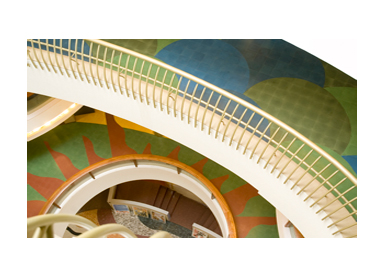 54Unitinta: Plain but VersatileThe Plain Jane's got something to say ! See what the Unitinta or single coloured Bharat tile can do!Read More
54Unitinta: Plain but VersatileThe Plain Jane's got something to say ! See what the Unitinta or single coloured Bharat tile can do!Read More -
 55Faiyaz MukhtiarSolid, dependable and meticulous. Here is how we would define Faiyaz Mukhtiar, CEO of BFT.Read More
55Faiyaz MukhtiarSolid, dependable and meticulous. Here is how we would define Faiyaz Mukhtiar, CEO of BFT.Read More -
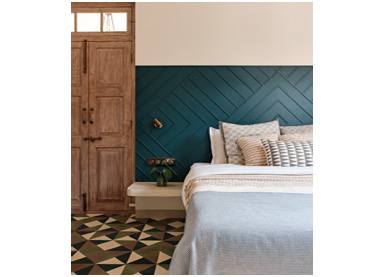 56Holiday with BharatView breathtaking holiday homes done up in Bharat's floors.Read More
56Holiday with BharatView breathtaking holiday homes done up in Bharat's floors.Read More

